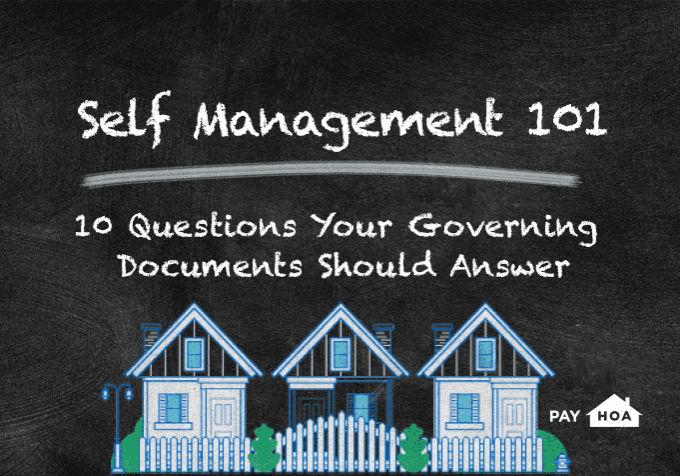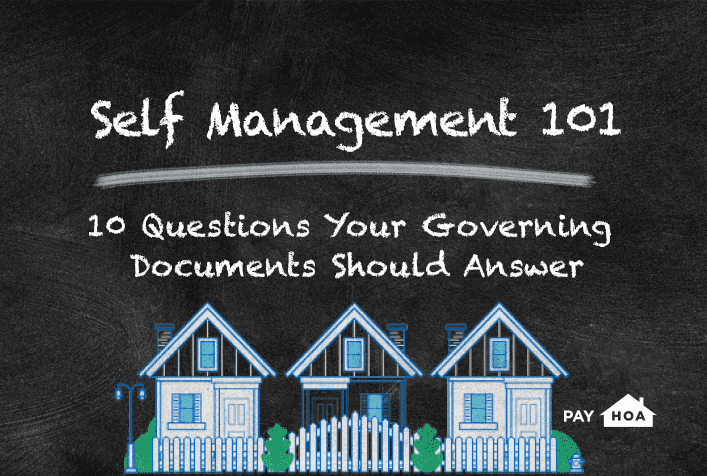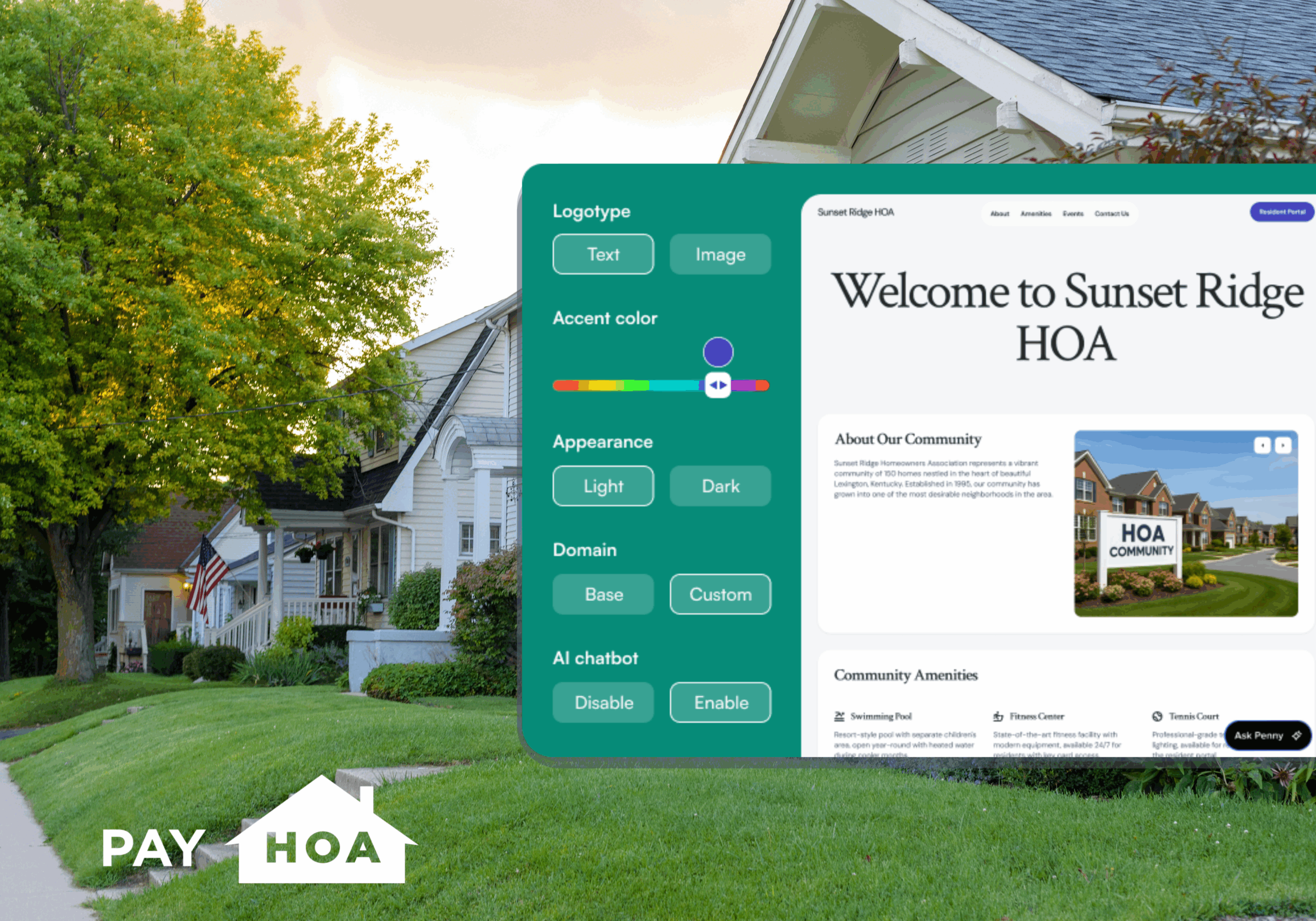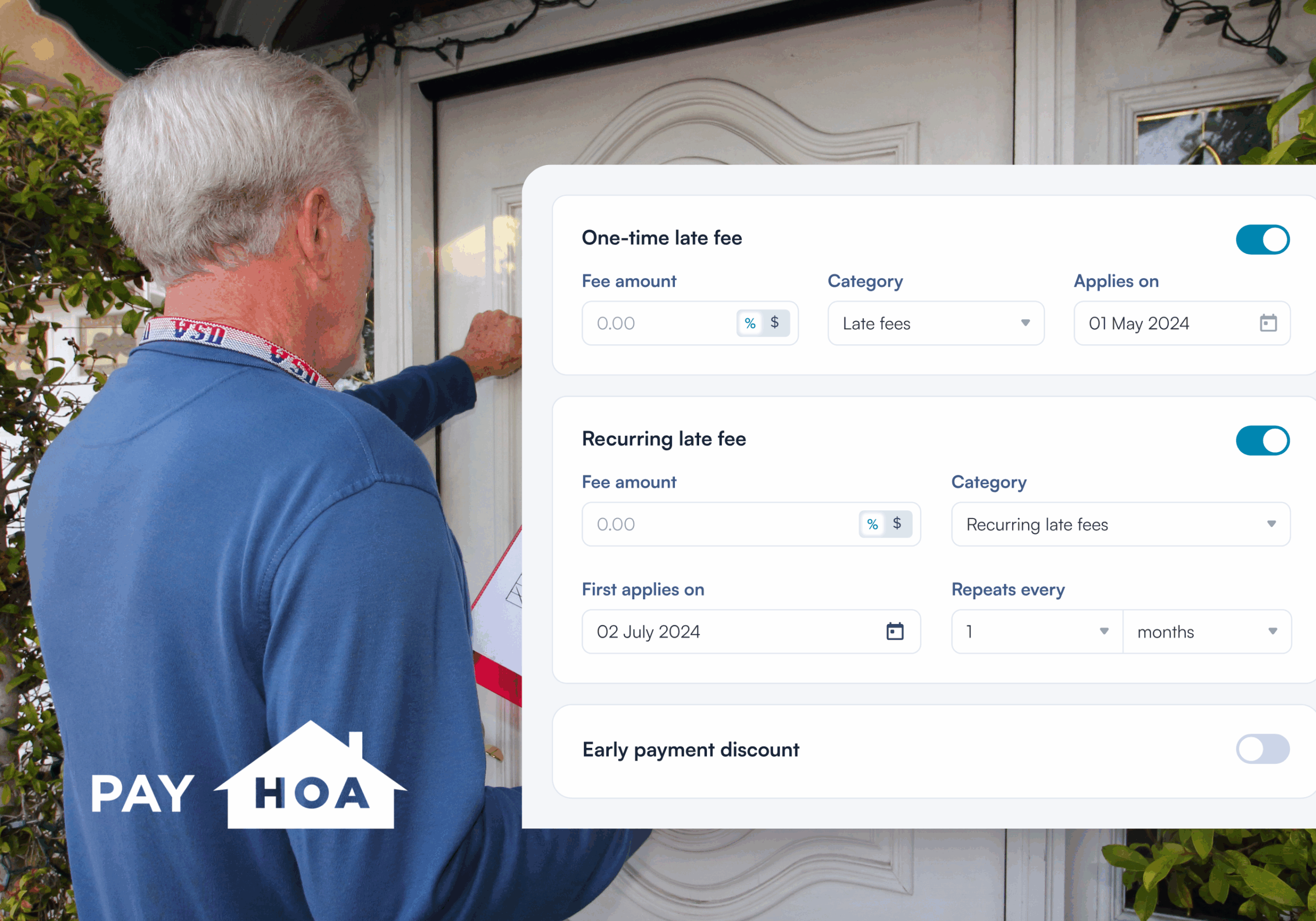 Mike Bollinger • 24 Sep 2021 • 9 min read
Mike Bollinger • 24 Sep 2021 • 9 min readSelf Management 101: 10 Questions Your Governing Documents Should Answer


Every successful homeowners association has one thing in common: how well they understand and follow their governing documents. For a self managed HOA, these documents play a critical role in the daily decisions made in managing a community.
The main documents governing an HOA and its residents include:
· Covenants, Conditions, & Restrictions (CC&Rs)
· Bylaws
· Rules and Regulations
Self managed HOAs will reference their governing documents often, as they outline exactly what the association must do to keep their community running smoothly, avoid legal risk, and keep within the boundaries of their authority.
Many self managed associations also invest in HOA self management software as a way to streamline storage and access of governing documents and community data, among other accounting and management tasks. Software management solutions give you the tools to put your knowledge and abilities to the best possible use.
With the right tools, coupled with the knowledge your governing documents provide, self managed HOAs can cut down on costs and help their neighborhoods thrive.
Table of Contents:
Questions CC&Rs Should Answer for Self Managed HOAs
1. What Property Use Rules Should Be Enforced?
2. Maintenance: What Is the HOA Responsible For?
3. What Protections Are Lenders Entitled To?
4. How Should You Enforce Rules Violations?
5. How Should You Set and Manage Assessments?
6. What Are the Insurance Requirements for Your Community?
Questions Bylaws Should Answer for Self Managed HOAs
1. What Exactly Are Board Members’ Duties?
2. How Many Board Members Should Serve at One Time?
3. What Are the Requirements for Board Meetings?
4. What Are the Steps for Board Member Elections?
Questions CC&Rs Should Answer for Self Managed HOAs
CC&Rs cover many important questions your association and residents alike may have about your rights and obligations to one another. This document is typically legally binding, and must be followed to avoid potential punitive measures for homeowners, or facing the risk of litigation if you’re a board member.
1. What Property Use Rules Should Be Enforced?

Property rules, when not clearly understood by HOAs and their residents, inevitably lead to conflict. For instance, can a resident plant a personal garden? What are the rules about upgrading a property’s exterior? If a homeowner violates the rules, what are the penalties, and how are they enforced?
Your CC&Rs should cover all the ins and outs of property use rules, including:
· Exterior aesthetics to maintain property values and curb appeal, such as paint color, shingles, and trim
· Architectural changes and improvements such as additions, renovations, upkeep, and maintenance of driveways
· Landscaping restrictions on types of plantable trees and bushes, fencing, and garden sculptures
· Defining parking rules such as for guest parking, resident parking in garages or on the street, overnight parking, and parking for RVs, trailers, and boats
· Trash placement and pickup times and dates
2. Maintenance: What Is the HOA Responsible For?
Maintenance costs money. Therefore, your association doesn’t want to accidentally foot the bill for maintenance that should be covered by individual homeowners. HOAs and residents alike want to live up to their obligations in maintaining their community.
CC&Rs will define whether your HOA or residents must landscape their yards, cover snow removal, upkeep common areas, or maintain “exclusive use” common areas such as condominium patios, porches, and window boxes.
3. What Protections Are Lenders Entitled To?

Mortgage lenders hold an important stake in your community and are entitled to certain protections in terms of how you manage your association. Your CC&Rs should clearly define these for all parties involved. Amending your CC&Rs may also require the approval of these lenders, especially as it pertains to assessments, rules enforcement, insurance coverage, and maintenance.
4. How Should You Enforce Rules Violations?
When homeowners violate community rules, it’s critical that both they and board members understand exactly how these rules will be enforced. CC&Rs define how each community must follow a specific timeline and process for issuing warning letters, holding hearings, assessing fines, and how long residents have to pay before taking further steps such as involving collections agencies or taking other legal action.
When HOAs provide clarity about rules and enforcement, it removes conflict and keeps the process objective and fair. Communicating with your homeowners about enforcement procedures helps prevent them from feeling slighted by their HOA.
The right HOA software gives you tools to communicate and bridge that gap:
- Mass texts, email, voicemail, and physical mail capabilities
- Direct, securely stored communications with homeowners via their personalized resident portals
- Build an association website to host important community information with no coding knowledge necessary
- Give residents permission to access securely stored governing documents and other files
5. How Should You Set and Manage Assessments?

Special rules govern how you should calculate assessments for monthly dues, sometimes according to factors like the square footage of a given property. CC&Rs also cover when dues must be collected, how to levy special assessments, and the process for addressing delinquencies. Clearly defined rules governing dues will ultimately lead to better collections.
6. What Are the Insurance Requirements for Your Community?
Self managed HOAs don’t have a third-party property manager to maintain insurance for them. This means they must ensure they’re keeping the proper level of insurance and supplemental insurance coverage. Homeowners must do so as well.
These obligations are covered by your governing documents and can include general liability property insurance, regular liability insurance, D & O, and other types of coverage.
Questions Bylaws Should Answer for Self Managed HOAs
Bylaws help an association understand their obligations for how they operate day to day as a nonprofit organization and can answer many questions about how to handle situations that board members are likely to encounter.
1. What Exactly Are Board Members’ Duties?
Self managed HOAs handle a majority of the day-to-day management of their community, and thus your bylaws can be extremely helpful in defining all the duties of board members.
When you’re self managing, you handle a variety of tasks such as:
· Budgeting and financial management
· Collecting dues and fees
· Monitoring and enforcing violations
· Vendor management
· Upkeep of shared areas and architecture
· Maintaining open communication with residents
· Storing and maintaining community records
Beyond your CC&Rs and bylaws, your community may also have additional rules and regulations for anything not covered in your other governing documents. These may be tailored specifically to your community and its needs.
Each of these documents plays a critical role in your association’s success, and you need to easily and securely access them. With the right HOA management software, you can store these documents, share them, and retrieve them easily from a streamlined central repository. This benefits homeowners as well. Residents can use your software to access community information you share with them, ensuring you’re always on the same page.
Not only does HOA management software let you store these documents, it helps you enact the duties they set out.
Accounting and financial management tools help you set budgets, sync your bank accounts for real-time accounting, produce detailed financial reports, and access financial analytics.
Digital dues collections allows for bulk invoicing of individual units in your community, and residents can pay dues and view past payments online using their personalized resident portals.
HOA software provides a holistic approach to management with other tools such as violation and maintenance request tracking, vendor management, and managing multiple communication channels with residents.
2. How Many Board Members Should Serve at One Time?
You want to avoid having too many or too few board members, especially since self management requires your association to act as a finely tuned machine with members fulfilling their roles as efficiently as possible.
A self managed HOA board should include at minimum a president to oversee day-to-day operations, preside board meetings, and execute contracts; as well as a treasurer to handle community finances, sign checks, and approve payments. The board secretary will document board meeting minutes and distribute them to homeowners.
One benefit of using a property management company is that they act as liaisons for daily operations. Self-managed associations are more directly responsible. Thus, they may decide to consult a team of outside experts for certain needs, such as legal counsel for risk management and a CPA for financial auditing.
Your bylaws define the exact number of board members you should have serving at one time, as well as how long a board member is required to serve. A member who has fulfilled their term may go on to serve additional terms.
3. What Are the Requirements for Board Meetings?
Board meetings help you communicate with residents and fellow board members about the community’s needs and goals. Since you may be required to give residents advanced notice of the details of upcoming board meetings, it’s important to have a clearly defined schedule for these meetings, such as quarterly or monthly, according to your bylaws. These documents will also state quorum requirements.
Easily communicate with members about board meetings via HOA software, search past communications, and share board minutes digitally.
4. What Are the Steps for Board Member Elections?
Nominating and electing new board members may depend on the specifics of how your community is run, and can have an impact on how efficiently your board operates.
That’s why it’s critical to have this clearly delineated in the bylaws in terms of:
· How often and when to hold elections
· The exact process for nominating and electing new board members
· Guidelines for running a campaign
· Voting rules
· Term length requirements
Whatever requirements your governing document set forth, HOA software can streamline and optimize a self managed HOA’s operations from top to bottom. PayHOA works with over 6,000 self managed HOAs across the country with a 98% user recommendation rating. Try our 30-day free trial to help you make an informed decision for your HOA.
PayHOA offers an HOA management software solution for HOAs of any size or managerial priorities. To find out if PayHOA fits all your HOA management needs, try our software free for 30 days.
Share this article:
Enjoyed this Article? Try Another!
What’s the Difference Between HOA Management and Condo Management?
Key Takeaways: Introduction You’re shopping for condo management software because you’re tired of juggling spreadsheets,…
Are HOAs Legally Required to Have a Website?
Key Takeaways Does our HOA Need a Website? Running a homeowners’ association is a considerable…
How to Collect HOA Payments Without Chasing Down Checks
Key Takeaways You didn’t sign up to be your community’s debt collector. Yet here you…


